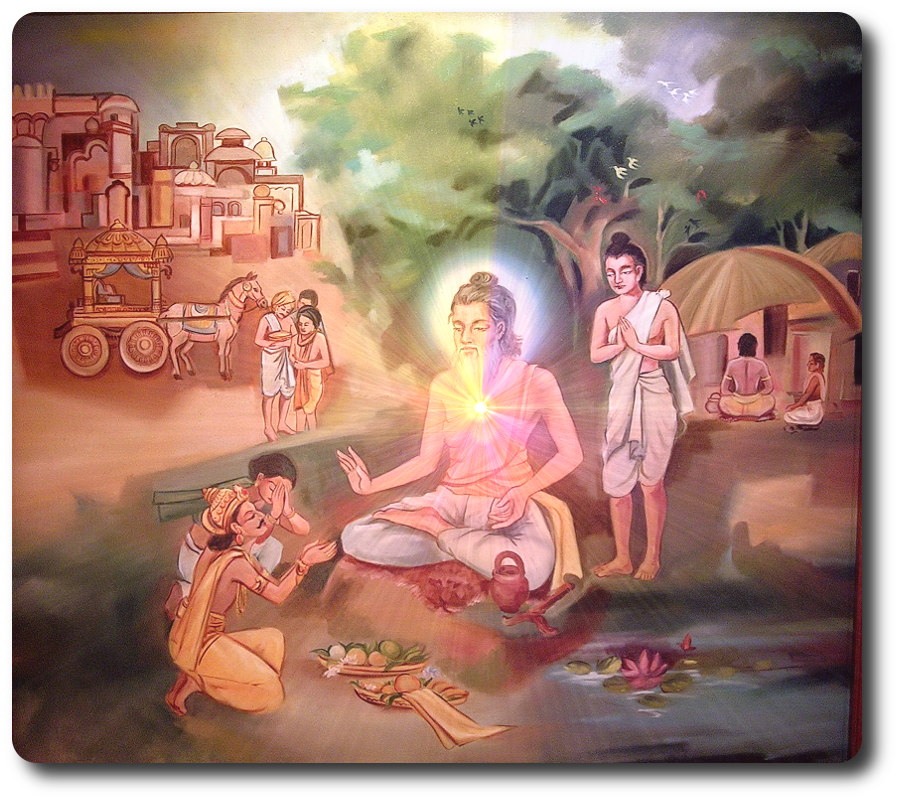“Spirituality and culture are synonyms in the Indian context. To be cultured, in the highest sense, is to be spiritual. The more advanced a culture becomes, the more spiritual it becomes because spirituality is the hallmark of a highly evolved mind.”
– Extract from ‘Indian Culture: Its Timeless Appeal and Ageless Charm‘ – The Vedanta Kesari 2012 December Special Issue, p499.
Bharatiya adhyatmik aitihyar sarsankshep (or Essentials of Spiritual Heritage of India) is a two-year certificate course (in Bengali) that covers Indian scriptures, ancient and modern. Every year there are 80 days of classes on Saturdays and Sundays. The classes are held from 3.15 pm to 5.45 pm, with a short break. The talks are delivered in Bengali, but the handouts of the course material are given in English. The answers in the exams can be written in English/Bengali/Hindi.
The Scriptures and topics covered in the course are listed below. An overview of the course, covering all these books, is presented in the beginning of the year, and then 2-3 Scriptures are covered each year. The classes are held in such a way as to present before the students the entire spiritual history of India. Most of these Scriptures are covered fully, but the larger ones are covered in part (essentials).
The Scriptures covered in the course

- Vedas
- Taittiriya Upanishad
- Prashna Upanishad
- Katha Upanishad
- Kena Upanishad
- Mandukya Upanishad
- Isa (Isha or Ishavasya) Upanishad
- Mundaka Upanishad
- Aitareya Upanishad
- Ramayana
- Mahabharata
- Bhagavad Gita
- Smritis
- Tantras
- Raja Yoga
- Narada Bhakti Sutras
- Chandi
- Bhagavatam
- Inspired Talks of Swami Vivekananda
- Aspects of Indian Philosophy with emphasis on Acharyas Shankara, Ramanuja, and Madhva.
- An overview of other major religions in India: Islam, Christianity, Buddhism, Jainism, and Sikhism.
Detailed Course Syllabus
Module 1: Vedas and Vedic Sages
- Overview of the Vedas: Samhitas, Brahmanas, Aranyakas, Vedangas
- The Vedic gods
- Selected Vedic Suktas: Agni, Medha, Nasadiya
- Peace Chants (Shanti-mantras) with meaning
- Vedic Rishis
Module 2: Upanishads and Upanishadic Sages
- Overview of the Upanishads
- Ishavasopanishad
- Kathopanishad
- Kenopanishad
- Brihadaranyaka and Chhandogya Upanishads
- Upanishadic Sages: Yajnavalkya, Satyakama, Svetaketu, etc.
Module 3: Sri Rama and Ramayana Tradition
- Valmiki and his Ramayana
- Adhyatma Ramayana
- Overview of Ramayana Traditions
- Sri Rama Sages: Tulasidas, Tyagaraja, etc.
Module 4: Vyasa and Mahabharata Tradition
- Overview of Mahabharata
- Important Selected Sections of Mahabharata
- Vidura Neeti, Sanat Sujateeya, etc.
- Mahabharata Sages: Vyasa, Vishwamitra, Shukadeva, Ashtavakra, Dattatreya, etc.
- The Various Gitas mentioned in Mahabharata
Module 5: The Bhagavad-Gita
Module 6: Smriti Shastra
Module 7: The Tantras
Module 8: The Puranas
- Overview of the Puranas
- The Eighteen Puranas—A Bird’s Eyeview
- Srimad Bhagavata Mahapurana
- Sri Krishna Sages: Surdas, Mirabai, etc.
- Chandi
Module 9: Scriptures and Saints of Other Religions
- Buddhism
- Jainism
- Sikhism
- Zorastrianism
- Judaism
- Christianity
- Islam
Module 10: Vedanta-Acharyas and Saints of Various Traditions in India
Module 11: The Ramakrishna Tradition
Download the Course Syllabus: PDF
Click here for Admission Details page
